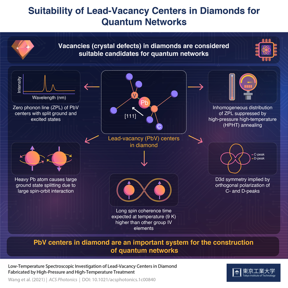Home > Press > How flawed diamonds ‘lead’ to flawless quantum networks
 |
| CREDIT
Tokyo Tech |
Abstract:
The color in a diamond comes from a defect, or vacancy, where there is a missing carbon atom in the crystal lattice. Vacancies have long been of interest to electronics researchers because they can be used as quantum nodes or points that make up a quantum network for the transfer of data. One of the ways of introducing a defect into a diamond is by implanting it with other elements, like nitrogen, silicon, or tin. In a recent study published in ACS Photonics, scientists from Japan demonstrate that lead-vacancy centers in diamond have the right properties to function as quantum nodes. The use of a heavy group IV atom like lead is a simple strategy to realize superior spin properties at increased temperatures, but previous studies have not been consistent in determining the optical properties of lead-vacancy centers accurately, says Associate Professor Takayuki Iwasaki of Tokyo Institute of Technology (Tokyo Tech), who led the study.
How flawed diamonds ‘lead’ to flawless quantum networks
Tokyo, Japan | Posted on October 1st, 2021
The three critical properties researchers look for in a potential quantum node are symmetry, spin coherence time, and zero phonon lines (ZPLs), or electronic transition lines that do not affect phonons, the quanta of crystal lattice vibrations. Symmetry provides insight into how to control spin (rotational velocity of subatomic particles like electrons), coherence refers to an identicalness in the wave nature of two particles, and ZPLs describe the optical quality of the crystal.
The researchers fabricated the lead-vacancies in diamond and then subjected the crystal to high pressure and high temperature. They then studied the lead vacancies using photoluminescence spectroscopy, a technique that allows you to read the optical properties and to estimate the spin properties. They found that the lead-vacancies had a type of dihedral symmetry, which is appropriate for the construction of quantum networks. They also found that the system showed a large ground state splitting, a property that contributes to the coherence of the system. Finally, they saw that the high-pressure high-temperature treatment they inflicted upon the crystals suppressed inhomogeneous distribution of ZPLs by recovering the damage done to the crystal lattice during the implantation process. A simple calculation showed that lead-vacancies had a long spin coherence time at a higher temperature (9K) than previous systems with silicon and tin vacancies.
The simulation we presented in our study seems to suggest that the lead-vacancy center will likely be an essential system for creating a quantum light-matter interfaceone of the key elements in the application of quantum networks, concludes an optimistic Dr. Iwasaki.
This study paves the way for the future development of large (defective) diamond wafers and thin (defective) diamond films with reliable properties for quantum network applications.
####
For more information, please click here
Contacts:
Kazuhide Hasegawa
Tokyo Institute of Technology
Copyright © Tokyo Institute of Technology
If you have a comment, please Contact us.
Issuers of news releases, not 7th Wave, Inc. or Nanotechnology Now, are solely responsible for the accuracy of the content.
News and information
![]() Two-dimensional hybrid metal halide device allows control of terahertz emissions October 1st, 2021
Two-dimensional hybrid metal halide device allows control of terahertz emissions October 1st, 2021
![]() Unprecedented view of a single catalyst nanoparticle at work: X-rays reveal compositional changes on active surface under reaction conditions October 1st, 2021
Unprecedented view of a single catalyst nanoparticle at work: X-rays reveal compositional changes on active surface under reaction conditions October 1st, 2021
Quantum communication
![]() Engineering various sources of loss provides new features for perfect light absorption: “Loss is ubiquitous in nature, and by better understanding it, we make it more useful” September 10th, 2021
Engineering various sources of loss provides new features for perfect light absorption: “Loss is ubiquitous in nature, and by better understanding it, we make it more useful” September 10th, 2021
![]() Researchers take quantum encryption out of the lab: Field trial shows simple QKD system works with existing telecommunication network in Italy June 11th, 2021
Researchers take quantum encryption out of the lab: Field trial shows simple QKD system works with existing telecommunication network in Italy June 11th, 2021
![]() Quantum holds the key to secure conference calls June 6th, 2021
Quantum holds the key to secure conference calls June 6th, 2021
![]() Quantum steering for more precise measurements April 23rd, 2021
Quantum steering for more precise measurements April 23rd, 2021
Possible Futures
![]() Fujitsu and Osaka University deepen collaborative research and development for fault-tolerant quantum computers October 1st, 2021
Fujitsu and Osaka University deepen collaborative research and development for fault-tolerant quantum computers October 1st, 2021
![]() Unprecedented view of a single catalyst nanoparticle at work: X-rays reveal compositional changes on active surface under reaction conditions October 1st, 2021
Unprecedented view of a single catalyst nanoparticle at work: X-rays reveal compositional changes on active surface under reaction conditions October 1st, 2021
Chip Technology
![]() Brought into line: FAU physicists control the flow of electron pulses through a nanostructure channel September 24th, 2021
Brought into line: FAU physicists control the flow of electron pulses through a nanostructure channel September 24th, 2021
![]() Switching on a superfluid: Exotic phase transitions unlock pathways to future, superfluid-based technologies September 24th, 2021
Switching on a superfluid: Exotic phase transitions unlock pathways to future, superfluid-based technologies September 24th, 2021
Discoveries
![]() Scientists discover spin polarization induced by shear flow October 1st, 2021
Scientists discover spin polarization induced by shear flow October 1st, 2021
![]() Inspired by photosynthesis, scientists double reaction quantum efficiency October 1st, 2021
Inspired by photosynthesis, scientists double reaction quantum efficiency October 1st, 2021
![]() Two-dimensional hybrid metal halide device allows control of terahertz emissions October 1st, 2021
Two-dimensional hybrid metal halide device allows control of terahertz emissions October 1st, 2021
Announcements
![]() Two-dimensional hybrid metal halide device allows control of terahertz emissions October 1st, 2021
Two-dimensional hybrid metal halide device allows control of terahertz emissions October 1st, 2021
![]() Unprecedented view of a single catalyst nanoparticle at work: X-rays reveal compositional changes on active surface under reaction conditions October 1st, 2021
Unprecedented view of a single catalyst nanoparticle at work: X-rays reveal compositional changes on active surface under reaction conditions October 1st, 2021
Interviews/Book Reviews/Essays/Reports/Podcasts/Journals/White papers/Posters
![]() Scientists discover spin polarization induced by shear flow October 1st, 2021
Scientists discover spin polarization induced by shear flow October 1st, 2021
![]() Unprecedented view of a single catalyst nanoparticle at work: X-rays reveal compositional changes on active surface under reaction conditions October 1st, 2021
Unprecedented view of a single catalyst nanoparticle at work: X-rays reveal compositional changes on active surface under reaction conditions October 1st, 2021










